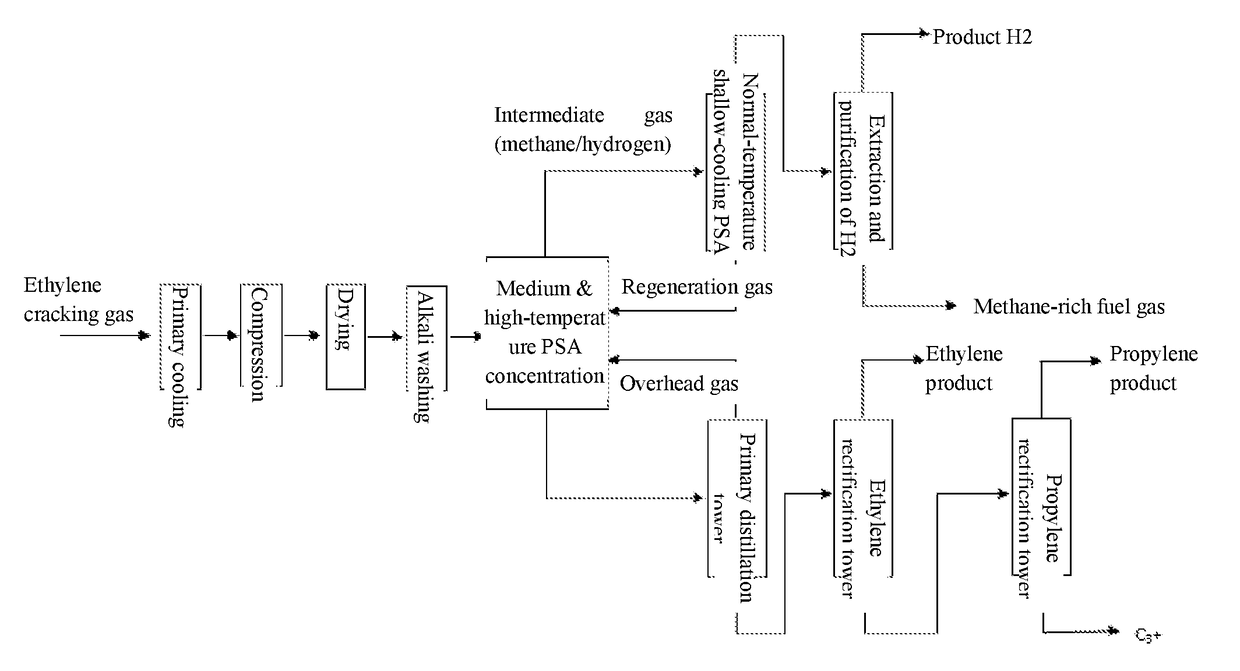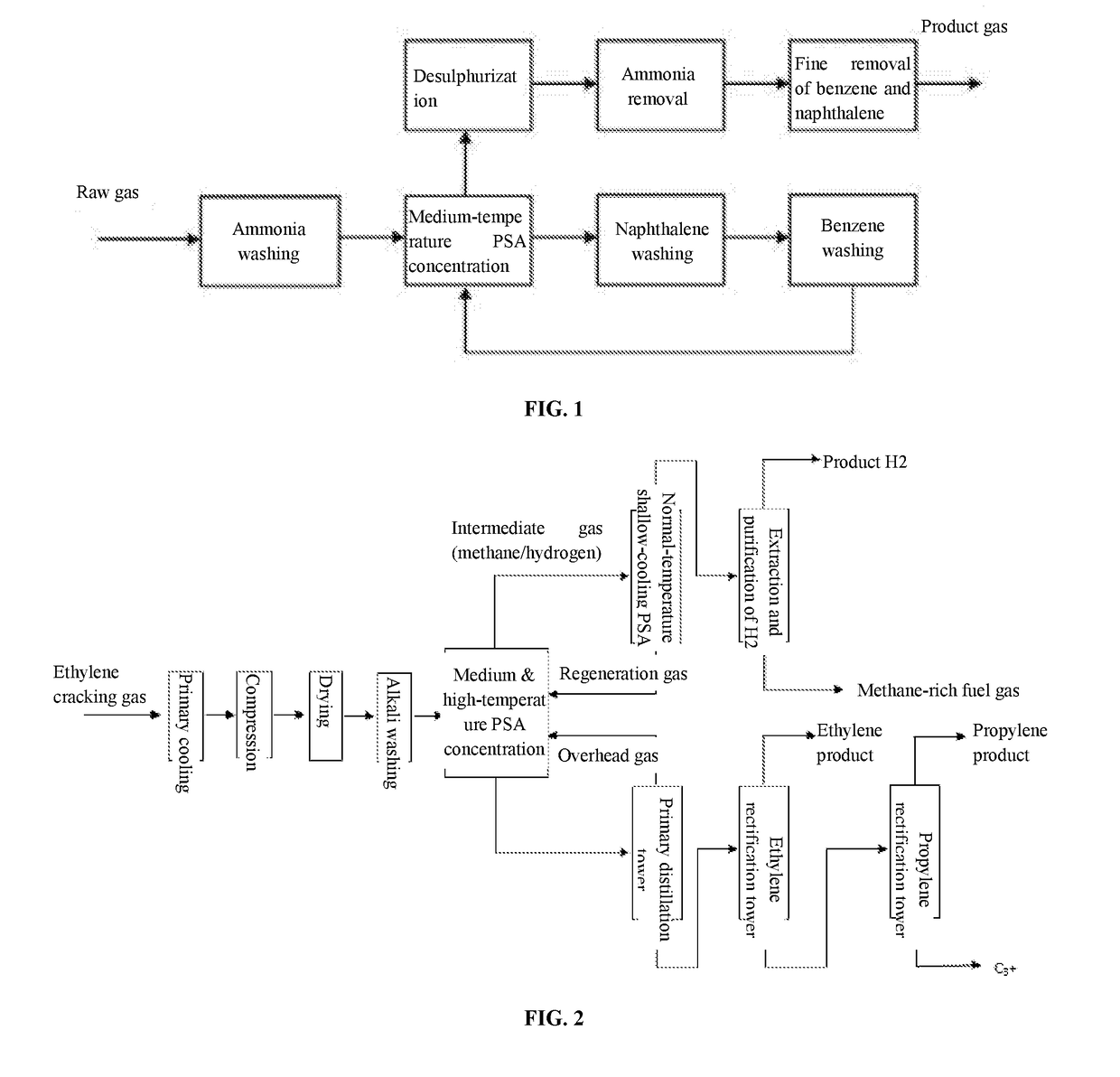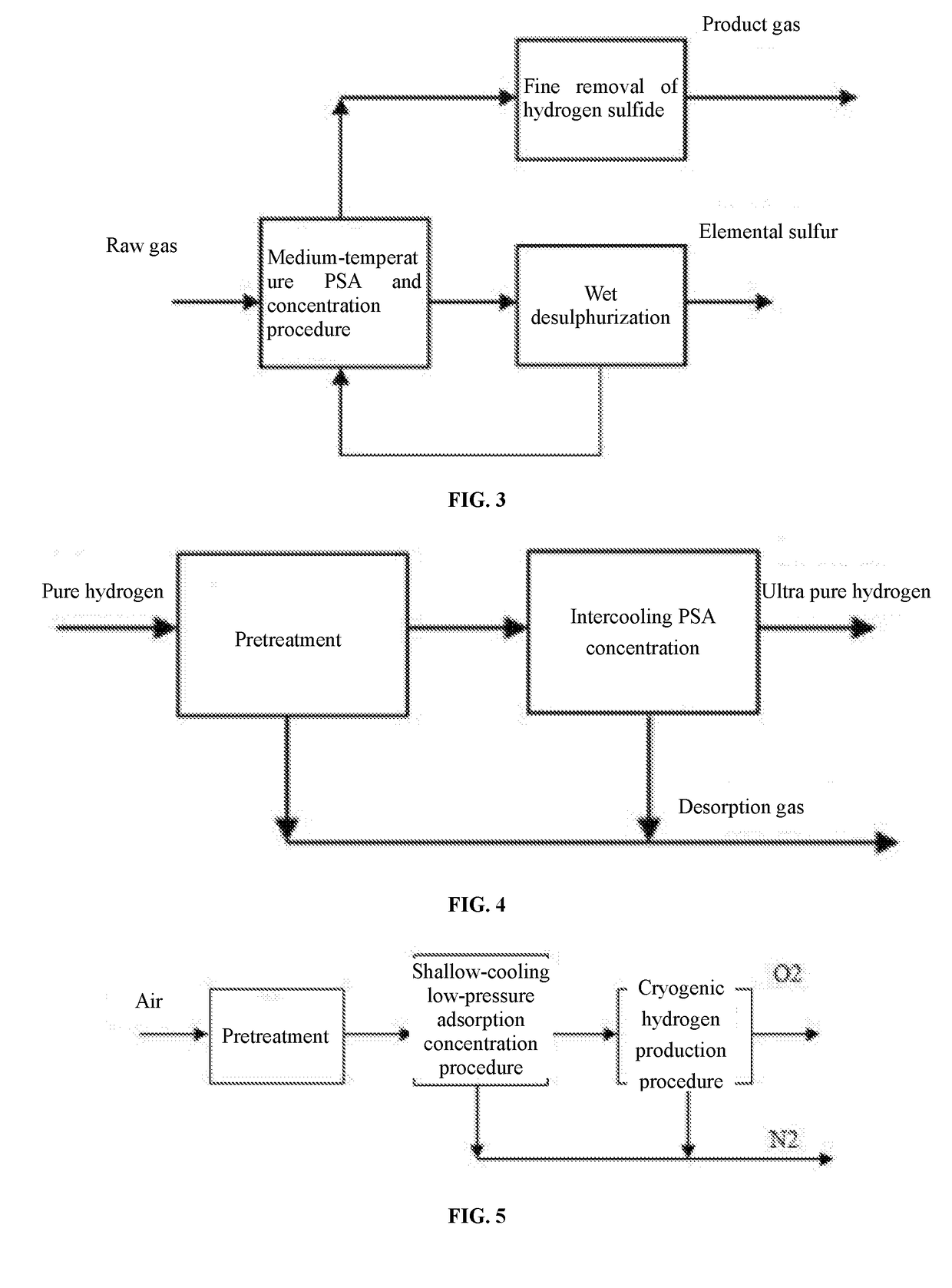Although
distillation has been widely used in the fields of
petrochemical refining, industry of fine chemicals,
coal chemical industry and the like, due to the existence of
phase transition and the coexistence of the processes of heat exchange and
mass transfer required in the form of repeated temperature rise and fall, its energy utilization ratio is relatively low, and the yield of the product cannot be improved while the purity of the product is improved.
The
distillation process is mainly treatment of liquid separation, but due to similar volatilities of organic solvents such as alcohols, ethers and esters, and components such as
alkane and olefine or the separation and purification conditions such as formation of
azeotrope, neither azeotropic rectification nor molecular rectification can effectively realize separation and purification; in a lot of fields of gas separation, purification and clarification such as removal and control of pollutants with dilute concentrations in
atmosphere, comprehensive utilization of industrial
tail gas and
industrial gas preparation,
distillation can be neither used as the most basic separation unit, nor used as the most common ultimate separation unit.
In the fields of separation and clarification such as
air separation, separation of ethylene
cracking gas and separation of synthesis gas, widely used (ultra) low temperature rectification (deep cooling) is at the expense of
high energy consumption, no effective utilization of self-contained energy of raw gas, and inexistence of effective
alternative technology at present.
That is to say, the temperature span from a high temperature raw gas, i.e. the ethylene
cracking gas, at the temperature of 700-900° C. at the cracking furnace outlet into material low temperature rectification (deep cooling) is very large, the self-contained energy of the material gas is hardly fully and effectively utilized, and the energy required from the outside is very large.
Those components with low boiling points, such as H2, N2, CO,
methane and the like which are not easily liquefied at low temperature or shallow cooling or normal temperature, form non-condensable gases, carrying small amounts of medium-and-high
boiling point components such as C2 and above throughout the main deep cooling and demethanizing
tower procedures, resulting in meaningless increase in the
energy consumption of these two procedures.
Small amounts of the non-condensable gases still continue to “play a bit role” in the subsequent low temperature or shallow cooling or normal temperature rectification procedure, resulting in energy waste in each rectification work section, increase in the
reflux ratio, and increase in the
operating cost.
These non-condensable gases eventually form ethylene
tail gas (
dry gas) generally used as
fuel gas directly, but effective components such as a large amount of H2 cannot be returned through recycling to a
refinery hydrogenation section requiring a large amount of
hydrogen.
However, only a series of rectification procedures themselves are improved, the huge energy carried by ethylene cracking gas itself cannot be effectively utilized, due to the limitation of the rectification
separation principle itself, these improvements and innovations still cannot change the current situation in the existing procedure of ethylene cracking and gas separation that the operation
energy consumption and production cost remain at a high level.
However, since there are various impurities to be removed from
coke oven gas, some of the physical properties of these impurities such as
boiling point,
solubility, equilibrium adsorption capacity and the like are very close and some are very different, the contents of all
impurity components are less than 10%, and the impurities will interfere with each other in terms of efficiency in their separation and clarification sections.
Therefore, if one step in the process of separation and clarification of
coke oven gas has not been handled properly, or the components in the raw gas fluctuate greatly, the efficiency of the next separation and clarification procedure will be greatly affected, so that the total cost of separation and clarification of
coke oven gas is increased.
In addition, through the separation and clarification of
coke oven gas, no clean
coke oven gas product can be obtained by directly using the ultra-low temperature or low temperature or shallow cooling rectification procedure just like separation of ethylene cracking gas.
Because the
coke oven gas contains a lot of low
boiling point components, while in cryogenic separation, a small amount of
impurity components such as sulfides,
ammonia, water,
naphthalene (crystallized) and the like which are easily liquified or crystallized and cured at low temperature do great harm such as
corrosion or blockage to cryogenic equipment, causing a potential safety
hazard in cryogenic operation.
Due to the consumption of more absorption solvents, the consumption of energy and materials is higher, and it is difficult to meet the requirement of higher clarification degree of
impurity removal or
product gas purity.
These gas sources usually contain a certain amount of H2S, and the temperature is usually in the range of 50−300° C. H2S impurities have great negative effects on the use of hydrogen-rich gas source in subsequent procedures, for example,
corrosion of equipment pipelines, excessive emission of
sulfur dioxide (SO2) from
fuel gas, catalyst and adsorbent poisoning and the like.
However, first, there are often impurity components, such as C2 and above,
carbon dioxide (CO2) and the like, which are easily absorbed in the hydrogen-rich gas source, there is the problem of competitive absorption with H2S absorption, leading to a decline in the desulphurization effect and a substantial increase in both the dosage of absorbent and the circulation and loss of regenerative load and absorbent, so that the absorption cost increases significantly; second, the temperature of the raw gas is higher, or the pressure is lower, but the absorption temperature is low, generally normal temperature, or the absorption pressure is higher, and as a result, the
absorbed energy consumption is relatively high, and
some energy carried by the raw gas itself cannot be fully utilized; third, since the H2S contents in most hydrogen-rich gas sources as raw gases are relatively low, the desulfurization efficiency by the absorption and
separation method is very low, the reason is also the same as the recycling of
refinery dry gas C2 and above in example 1, the absorbed H2S concentration and
partial pressure are lower, as a result, the difference between its
partial pressure and its saturated
vapor pressure is too small, or there is even no difference, the necessary driving force for absorption is insufficient, the
absorption efficiency is very low, or it is even impossible to absorb, fourth, H2S removal by the absorption and
separation method is limited in depth which can only reach 10-100 ppm, and it is difficult to meet the requirement of less than 0.1-1 ppm.
However, the requirement of higher clarification degree of removed impurities or higher purity of product components is still difficult to effectively meet.
Compared with the field of gas separation, the application of extraction technology is seriously limited.
Even if some gas separation conditions are
usable, there are some problems similar to absorption, for example, excessive consumption and loss of extractant, no full utilization of self-contained energy of raw gas, not high extraction efficiency and the like.
Membrane separation has the greatest
disadvantage that the membrane material is highly expensive and easily contaminated by impurities, resulting in its short service life and higher cost, and many pretreatment aids need to be set to protect the clean membrane itself from being contaminated.
In addition, the manufacturing of the membrane material itself is underdeveloped in China, the quality cannot be guaranteed, thus greatly restricting the popularization and application of membrane
separation technology.
Currently, membrane separation cannot become a widely used basic
unit operation for the time being.
Gas
adsorption separation is often considered as the ultimate
unit operation which can extract high purity
product gas and remove some impurities in depth, but cannot undertake basic separation tasks such as rectification, absorption and other conventional separation techniques.
Also, the self-energy of the raw gas cannot be fully utilized either under many working conditions.
Despite some advantages as above, the conventional PSA has some significant disadvantages: (1) the product yield is low; (2) the contradiction between adsorption and desorption cannot be solved, the applications in many occasions such as desorption and clarification of trace impurities, adsorption and recycling of components with low
partial pressure and the like are limited; (3) weakly polar impurities are difficult to adsorb, and highly polar trace impurities are difficult to desorb and regenerate; (4) as operating basically at normal temperature, the conventional PSA fails to effectively utilize the self-contained energy of the raw gases at a high or low temperature, and to achieve the cyclic operation of adsorption and desorption regeneration as well as the high efficiency of separation, purification and clarification; (5) there are many more sequencing valves, with a high
failure rate.
Since the heat
conductivity of the commonly used adsorbent is relatively low and both heating and cooling take a long time, the adsorption
bed is relatively large, corresponding heating and cooling facilities are also to be provided, both energy consumption and investment are high, and the operation is more troublesome.
In addition, substantial periodic changes in the temperature will affect the adsorbent life.
However, the general TSA method has obvious disadvantages in the treatment of many gas separation conditions, such as industrial
tail gas or
waste gas, which are mainly reflected in several aspects as follows: first, the cycle period of the TSA method is long: since the heating and cooling process is relatively slow, which usually takes several hours or more than a day, so the adsorption time must be equal to or greater than the regeneration time to ensure that the
bed adsorbate in an adsorption state is not penetrated at the end of regeneration.
For this reason, the TSA process is not suitable for the working conditions with
diffusion rate as the mechanism for adsorption, for example, the carbon
molecular sieve (CMS) adsorbent is used to separate and extract
nitrogen from air; second, the TSA method has a narrow scope of application: the TSA method is generally more suitable for the removal of trace impurities and the gas purification process, or occasions where it is difficult to regenerate completely by PSA depressurization or flushing.
Under conditions without common
inert gas sources or
nitrogen or conditions where these gas sources cannot be used as the regeneration gas, the clarified gas itself can be used as a regenerative carrier, but this will lead to a decrease in the yield of clarified gas or an increase in the circulating load of the TSA method.
In addition, the flow rate of the regenerative
heat carrier selected by the TSA method is relatively high, the operation cost will be further increased, particularly in the process of removal of trace impurities, a large number of heat carriers are used to heat a
dead space in the adsorption
bed, so that uneven temperature distribution and stagnation in the adsorption bed are increased, the turbulence phenomenon is serious, so that the efficiency of bed
mass transfer is low.
Sometimes impure
nitrogen can be used directly as regeneration gas, but the service life of the adsorbent will be affected.
Even if the subsequently added
treatment system allows recycling or emission, other regeneration gases have to be used as heat carriers because of high investment and diseconomy, or the TSA method cannot be used to realize the desorption of VOCs; sixth, the application of the TSA method has certain potential safety hazards: for example, when a gas with more than 8-10% (v / v %)
oxygen content, especially air, is used as the regeneration gas, and when the adsorbate components are volatile materials or easy to have oxidation reactions, if the regeneration temperature is improperly controlled, or when a sudden stop is encountered and the heat in the bed is not taken away in time, the commonly used adsorbent is
activated carbon which will burn or explode, resulting in a great potential safety
hazard; again, for instance, when VOCs or acid components are removed and recycled by the TSA method, the corrosivity of regeneration gas becomes very sensitive, especially under the condition where
vacuum pumping (negative pressure) is required in order to make the adsorbent regenerate completely, the
corrosion of acid gases to the
vacuum pump or the corrosion of volatile components to the valve seal and the like will lead to leakage and air introduction, which will also cause serious potential safety hazards; seventh, the TSA method is not suitable for conditions with higher concentration of most adsorbates in the raw gas: this is due to the need for a large number of adsorbents or more adsorption beds standing side by side to match the time in the adsorption phase with the regeneration time, and the investment and operation costs are quite high; eighth, the service life of adsorbents in the TSA method is not long.
Too high temperature will also deteriorate or pulverize the adsorbents.
However, since this TPSA method is still dominated by PSA, the regeneration process is mainly done by pressure swing rather than only by temperature swing, the technical bottlenecks of
high energy consumption, high consumption of adsorbents, difficult matching of adsorption and regeneration time, narrow applications, need for selection of
heat carrier as regeneration gas and the like existing in the TSA method are not fundamentally solved.
Under some conditions, the application of the TPSA method can also bring the practical problems of difficult operation, increase in investment, short service life of adsorbents and the like.
However, the vast majority of such
coupling processes still regulates or matches on the basis of the conventional separation methods, and they can neither fundamentally solve many problems in the conventional separation methods nor replace the basic role of the conventional separation methods.
Meanwhile, the self-contained energy specific to raw gas cannot be fully used, or the
application areas of general PSA or TSA or TPSA cannot be expanded.
 Login to View More
Login to View More 


